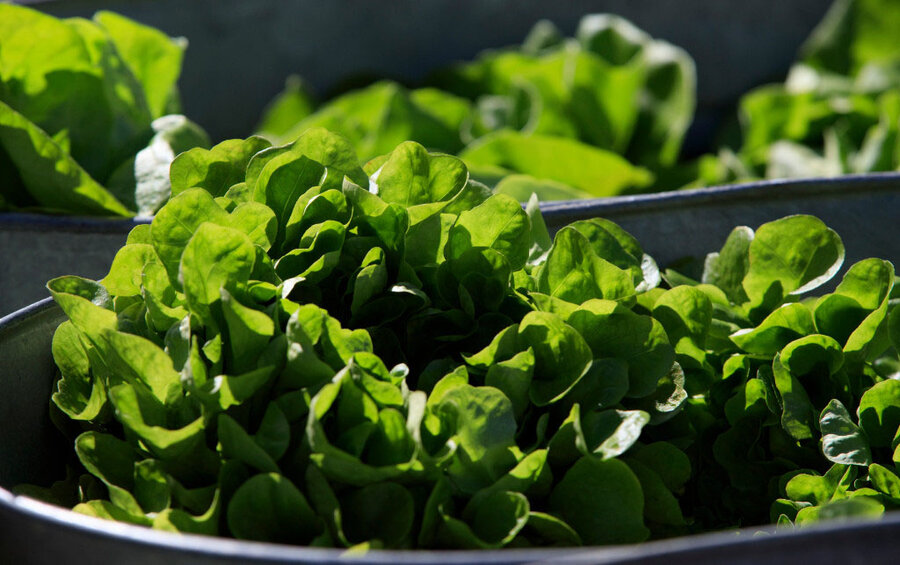In lettuce price spike, a taste of things to come
Loading...
Looking for deals at your local supermarket? Steer clear of the lettuce rack.
According to the US Department of Agriculture, a head of romaine cost $1.78 on April 21st, up from $1.23 in early January. While the consumer price index shows that the rest of the produce aisle is also getting more pricey, leafy-green lovers can blame one clear cause: bad weather.
After years of drought, California – whose Salinas Valley is called “the salad bowl of the world” – is facing the opposite problem. Heavy rains in January and February restricted the winter planting season for lettuce, celery, and spinach, meaning that fewer of those crops than usual are maturing. To make matters worse, a colder-than-usual winter took a huge bite out of Spain’s vegetable crop, leaving European consumers dependent on California’s scarce veggies.
It’s hard to definitively link this squeeze – or any one weather event – to climate change. And spikes like these aren’t new: “horticultural product prices fluctuate enormously,” reports the UN’s Food and Agriculture Organization (FAO).
But episodes like today’s lettuce bubble could grow more common as weather in key farming regions gets less predictable, a problem that will demand solutions from both suppliers and consumers.
Charlie Iceland, aqueduct director with the World Resources Institute’s (WRI’s) Water Program, tells The Christian Science Monitor that “one of the things climate-change scientists predict are more of the extremes of drought and flooding.”
“In this case,” he continues, “flooding is doing the damage to the crops, to the lettuce, but either one can do a lot of damage, and they're going to create supply-demand imbalances and price spikes ... and I think that'll happen more often.”
His colleague Rich Waite, an associate with the WRI’s Food Program, doesn’t mince words about the scale of this challenge. In a phone interview, he asks, “How are we going to feed 9 or 10 billion people by 2050 in a way that advances development but also reduces pressure on the environment, and does so under a changing climate, and under growing resource constraints? There's this whole menu of things that the world is going to need to do.”
That could prove especially true for lettuce and other vegetables. The World Health Organization aims to increase global consumption of this food group, but it’s not exactly poised to thrive as the weather gets less reliable.
“If you have enough water, it's easier to grow vegetables without rain than with rain,” Frank Mangan, extension professor at the University of Massachusetts–Amherst Stockbridge School of Agriculture, tells the Monitor. Rainfall doesn’t just make it harder to work in the fields; too much water can also “lead to disease, leaching of nutrients, things like that,” he explains.
Usually, California’s dry climate spares lettuce growers these headaches, and its massive dam and canal system keeps each head properly hydrated. The Golden State produces 71 percent of the nation’s lettuce; it and a few other US regions with the right mix of climatic, geologic, and economic factors supply the bulk of America’s greens.
When strange weather hits these areas, consumers far and wide feel the pain. But as this problem unfolds with lettuce, the food-supply chain is adapting. In Chicago, for instance, the fast-casual restaurant Just Salad has locked in future contracts for lettuce and other produce it serves so it can preserve its prices against market swings, reports the Chicago Tribune. Meanwhile, Bloomberg reports that a greenhouse chain based in New York that supplies supermarkets with lettuce, tomatoes, and basil is seeing an uptick in business as California’s supply looks less certain.
These solutions will need a drastic scale-up to fill the salad bowls of 3 billion more humans by mid-century. In 2014, US greenhouses sold $797 million worth of vegetables, only about 4 percent of that year's $19 billion domestic crop. It’s also just one of what the WRI’s Waite and Iceland call a “menu of solutions,” which also features high-tech fixes, like new crop varieties, and more common-sense approaches, like curbing food waste.
On the demand side, another change that could buffer the price shock of severe weather – spreading out production of crops like lettuce – might not be painless. “If you were to try to push the production of a certain crop outside of its usual place,” Mr. Iceland explains, “I'm assuming that entails some kind of a markup in price, because it's a less efficient place, so the consumer would have to be willing to go along and pay a higher price.”
Or find a cheaper alternative. Feeling the pinch of the current lettuce crisis, the Greater Chicago Food Depository maintained a balanced diet for its low-income clients while staying within budget. The food bank’s spokesman, Jim Conwell, told the Tribune that “kale and cabbage have remained more affordable, so we're purchasing and distributing more of those items.”
In coming years, consumers around the world and across the income scale will likely have to make more adjustments like these.
“A lot of the conversation around how to sustainably feed more people in a changing climate has to focus on the agriculture,” says Waite, but “the other half of the solution is about making consumption patterns more sustainable, too.”
“We’ve seen that it really is a combination of those supply-side and those demand-side measures that are gonna get us to a point where the world is fed in a sustainable way by mid-century.”






